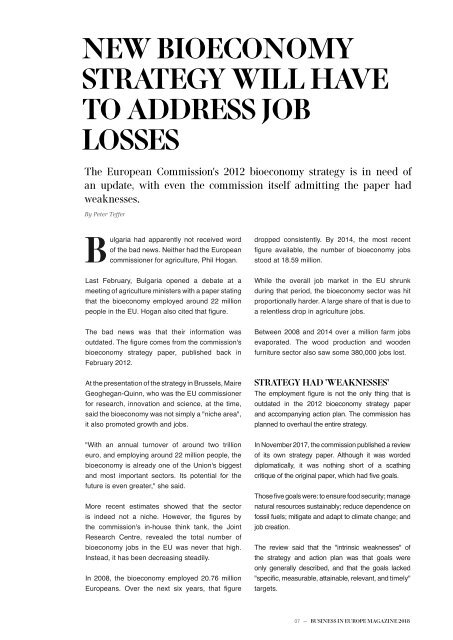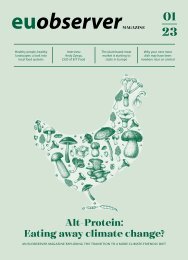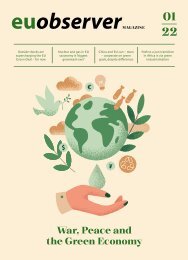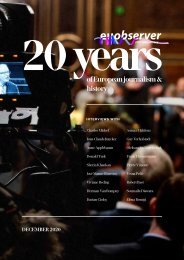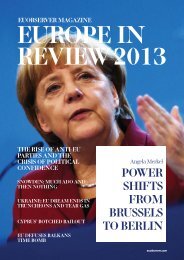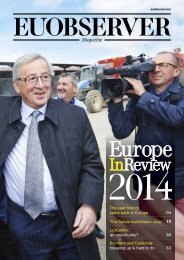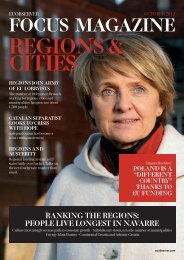Europe's Bioeconomy: The Business of Nature
EUobserver's 2018 Business in Europe magazine takes a closer look at Europe's bioeconomy and how "the business of nature" is changing the way people look at waste and natural resources.
EUobserver's 2018 Business in Europe magazine takes a closer look at Europe's bioeconomy and how "the business of nature" is changing the way people look at waste and natural resources.
Create successful ePaper yourself
Turn your PDF publications into a flip-book with our unique Google optimized e-Paper software.
NEW BIOECONOMY<br />
STRATEGY WILL HAVE<br />
TO ADDRESS JOB<br />
LOSSES<br />
<strong>The</strong> European Commission's 2012 bioeconomy strategy is in need <strong>of</strong><br />
an update, with even the commission itself admitting the paper had<br />
weaknesses.<br />
<br />
Bulgaria had apparently not received word<br />
<strong>of</strong> the bad news. Neither had the European<br />
commissioner for agriculture, Phil Hogan.<br />
dropped consistently. By 2014, the most recent<br />
<br />
stood at 18.59 million.<br />
Last February, Bulgaria opened a debate at a<br />
meeting <strong>of</strong> agriculture ministers with a paper stating<br />
that the bioeconomy employed around 22 million<br />
<br />
While the overall job market in the EU shrunk<br />
during that period, the bioeconomy sector was hit<br />
proportionally harder. A large share <strong>of</strong> that is due to<br />
a relentless drop in agriculture jobs.<br />
<strong>The</strong> bad news was that their information was<br />
<br />
bioeconomy strategy paper, published back in<br />
February 2012.<br />
At the presentation <strong>of</strong> the strategy in Brussels, Maire<br />
Geoghegan-Quinn, who was the EU commissioner<br />
for research, innovation and science, at the time,<br />
said the bioeconomy was not simply a "niche area",<br />
it also promoted growth and jobs.<br />
Between 2008 and 2014 over a million farm jobs<br />
evaporated. <strong>The</strong> wood production and wooden<br />
furniture sector also saw some 380,000 jobs lost.<br />
STRATEGY HAD 'WEAKNESSES'<br />
<br />
outdated in the 2012 bioeconomy strategy paper<br />
and accompanying action plan. <strong>The</strong> commission has<br />
planned to overhaul the entire strategy.<br />
"With an annual turnover <strong>of</strong> around two trillion<br />
euro, and employing around 22 million people, the<br />
bioeconomy is already one <strong>of</strong> the Union's biggest<br />
and most important sectors. Its potential for the<br />
future is even greater," she said.<br />
More recent estimates showed that the sector<br />
<br />
the commission's in-house think tank, the Joint<br />
Research Centre, revealed the total number <strong>of</strong><br />
bioeconomy jobs in the EU was never that high.<br />
Instead, it has been decreasing steadily.<br />
In 2008, the bioeconomy employed 20.76 million<br />
<br />
In November 2017, the commission published a review<br />
<strong>of</strong> its own strategy paper. Although it was worded<br />
diplomatically, it was nothing short <strong>of</strong> a scathing<br />
<br />
<br />
natural resources sustainably; reduce dependence on<br />
fossil fuels; mitigate and adapt to climate change; and<br />
job creation.<br />
<strong>The</strong> review said that the "intrinsic weaknesses" <strong>of</strong><br />
the strategy and action plan was that goals were<br />
only generally described, and that the goals lacked<br />
<br />
targets.<br />
07 — BUSINESS IN EUROPE MAGAZINE 2018


